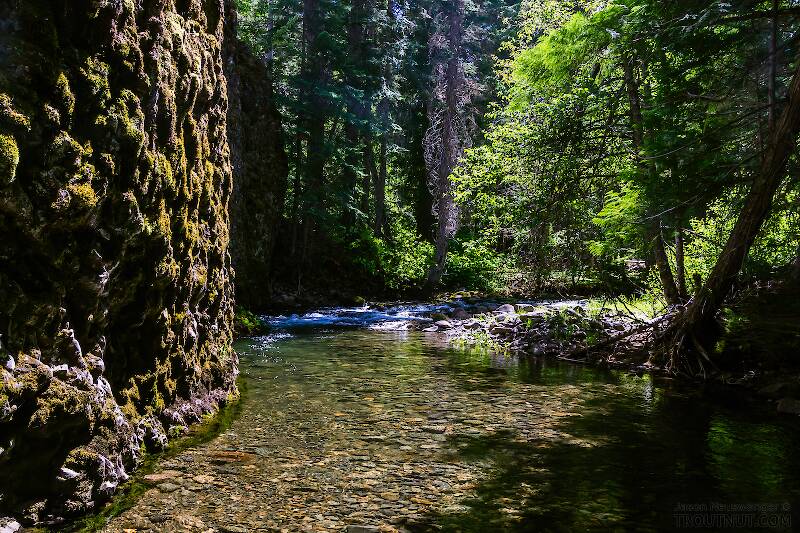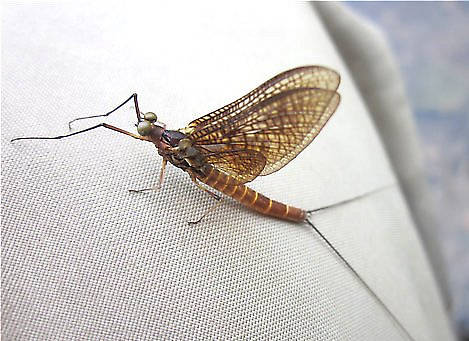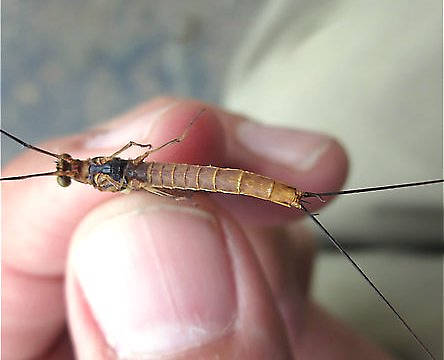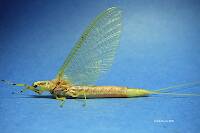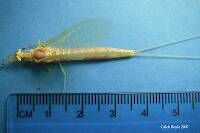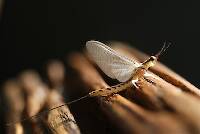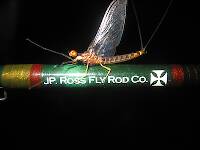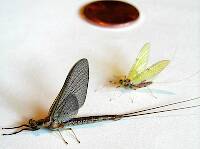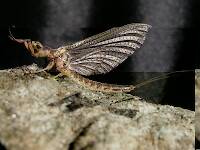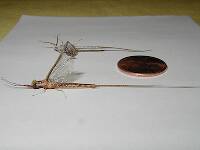
Salmonflies
Pteronarcys californica
The giant Salmonflies of the Western mountains are legendary for their proclivity to elicit consistent dry-fly action and ferocious strikes.
Featured on the forum

Troutnut is a project started in 2003 by salmonid ecologist Jason "Troutnut" Neuswanger to help anglers and
fly tyers unabashedly embrace the entomological side of the sport. Learn more about Troutnut or
support the project for an enhanced experience here.
This topic is about the Mayfly Genus Litobrancha
This genus is very closely related to Hexagenia. Its only species, Litobrancha recurvata, can be quite important.Example specimens
Dryfly on Aug 29, 2009August 29th, 2009, 6:07 pm EDT
Sorry no photo
While out fishing I came across a big drake spinner. I think it might be Litobrancha Recurvata. 2 tails 17 mm body length, front pair of legs darker than back two, olive abdomen, darker thorax. Collected August 28th, which is relatively late for Litobrancha. Also could be Hexagenia Rigida or Atrocaudata.
Anyone know if Litobrancha or the Late Hexs are present in Southeast Mn?
While out fishing I came across a big drake spinner. I think it might be Litobrancha Recurvata. 2 tails 17 mm body length, front pair of legs darker than back two, olive abdomen, darker thorax. Collected August 28th, which is relatively late for Litobrancha. Also could be Hexagenia Rigida or Atrocaudata.
Anyone know if Litobrancha or the Late Hexs are present in Southeast Mn?
GONZO on Aug 30, 2009August 30th, 2009, 10:21 am EDT
Dryfly,
L. recurvata is recorded for MN, though the records appear to be from the northeastern corner. I haven't seen records of H. atrocaudata or rigida from MN, but they should probably be expected. They are recorded for WN and IA, with some records close to southeastern MN. H. limbata and bilineata are recorded for MN and are the most common Hexagenia species throughout most of the upper Mississippi River area. Although the peak of their hatch is usually earlier, stragglers of either species can be found into early September.
L. recurvata seems a bit unlikely. As you note, it is usually a fairly early emerger--around the end of May or beginning of June in my area, and probably June into early July in the upper Midwest. Although 17mm is just within the lower size range, this is the largest North American mayfly, with some specimens approaching 40mm. More significantly, I think you would have noticed the unusually dark wings. Even in the spinner stage, they have dark veins and a bronzy stain in the membrane of the wings.
If it was H. atrocaudata, you probably should have seen a dark border around the rear of the hind wing (though that dark border can also be found in some limbata, some rigida, and most bilineata).
L. recurvata is recorded for MN, though the records appear to be from the northeastern corner. I haven't seen records of H. atrocaudata or rigida from MN, but they should probably be expected. They are recorded for WN and IA, with some records close to southeastern MN. H. limbata and bilineata are recorded for MN and are the most common Hexagenia species throughout most of the upper Mississippi River area. Although the peak of their hatch is usually earlier, stragglers of either species can be found into early September.
L. recurvata seems a bit unlikely. As you note, it is usually a fairly early emerger--around the end of May or beginning of June in my area, and probably June into early July in the upper Midwest. Although 17mm is just within the lower size range, this is the largest North American mayfly, with some specimens approaching 40mm. More significantly, I think you would have noticed the unusually dark wings. Even in the spinner stage, they have dark veins and a bronzy stain in the membrane of the wings.
If it was H. atrocaudata, you probably should have seen a dark border around the rear of the hind wing (though that dark border can also be found in some limbata, some rigida, and most bilineata).
Dryfly on Aug 30, 2009August 30th, 2009, 1:21 pm EDT
Thanks for weighing in on my question. The hind wing's back edge is a bit darker. This is just the edge though. Does that sound like Atrocaudata?
GONZO on Aug 30, 2009August 30th, 2009, 3:26 pm EDT
Possibly. Is it a male? (Claspers will be present at the tip of the abdomen.) If so, and it's atrocaudata, the eyes should be quite close together on top of the head. Take a look at Jason's examples to see what I mean, and compare the dorsal and ventral markings to his:
http://www.troutnut.com/specimen/472
http://www.troutnut.com/specimen/206
If it's a female, the eyes will be smaller and further apart, but the abdominal markings should still be similar, as in this female dun:
http://www.troutnut.com/specimen/474
(Sometimes the markings might not be quite as dark.)
http://www.troutnut.com/specimen/472
http://www.troutnut.com/specimen/206
If it's a female, the eyes will be smaller and further apart, but the abdominal markings should still be similar, as in this female dun:
http://www.troutnut.com/specimen/474
(Sometimes the markings might not be quite as dark.)
Dryfly on Aug 30, 2009August 30th, 2009, 4:07 pm EDT
It's a female. The colors have likely darkened considerably as it's two days old and now dead. It does have some of the same abdominal marking as the second male spinner. So it is most likely Hexagenia Atrocaudata. Thanks for your help Gonzo.
GONZO on Aug 30, 2009August 30th, 2009, 4:38 pm EDT
My pleasure, Dryfly. There are records of atrocaudata south of you in Winneshiek and Fayette counties in Iowa, so it seems quite reasonable.
Quick Reply
Related Discussions
Topic
Replies
Last Reply
1
Aug 1, 2008
by Troutnut
by Troutnut
3
May 31, 2016
by Oldredbarn
by Oldredbarn
Re: Does anyone know anything about Heptagenia culacantha?
In the Mayfly Species Heptagenia culacantha by GONZO
In the Mayfly Species Heptagenia culacantha by GONZO
8
Apr 18, 2007
by Konchu
by Konchu

